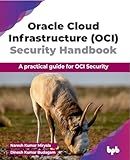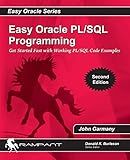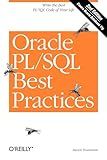Best Oracle Database Tools to Buy in December 2025

OCE Oracle Database SQL Certified Expert Exam Guide (Exam 1Z0-047) (Oracle Press)
- MINT CONDITION: ENJOY YOUR PRODUCT IN PRISTINE QUALITY!
- SAME-DAY DISPATCH: ORDER BY NOON FOR QUICK DELIVERY!
- GUARANTEED RETURNS: HASSLE-FREE RETURNS FOR COMPLETE PEACE OF MIND!



Oracle 12c For Dummies



Oracle 12c: SQL



Oracle Database 12c The Complete Reference (Oracle Press)
- AFFORDABLE PRICES WITH QUALITY ASSURANCE FOR SAVVY READERS.
- ECO-FRIENDLY CHOICE: PROMOTE SUSTAINABILITY WITH REUSED BOOKS.
- UNIQUE FINDS: DISCOVER HIDDEN GEMS AND RARE EDITIONS TODAY!



Quick Start Guide to Oracle Fusion Development: Oracle JDeveloper and Oracle ADF (Oracle Press)



Oracle Regular Expressions Pocket Reference
- AFFORDABLE PRICING FOR QUALITY LITERATURE AT YOUR FINGERTIPS.
- ECO-FRIENDLY CHOICE: REDUCE WASTE BY BUYING USED BOOKS.
- UNIQUE FINDS: DISCOVER RARE TITLES AND HIDDEN GEMS TODAY!



Oracle Database 11g DBA Handbook (Oracle Press)



Oracle Cloud Infrastructure (OCI) Security Handbook: A practical guide for OCI Security (English Edition)



Easy Oracle PLSQL Programming: Get Started Fast with Working PL/SQL Code Examples (Easy Oracle Series)



Oracle PL/SQL Best Practices: Write the Best PL/SQL Code of Your Life
- AFFORDABLE PRICES FOR QUALITY USED BOOKS-SAVE BIG TODAY!
- THOROUGHLY CHECKED: RELIABLE CONDITION FOR YOUR READING PLEASURE.
- ECO-FRIENDLY CHOICE: SUPPORT SUSTAINABILITY WITH EVERY PURCHASE!


To connect to an Oracle Database using SQL*Plus, follow these steps:
- Open a command prompt or terminal window.
- Type sqlplus followed by your username and password in the format sqlplus username/password@hostname/service_name. Replace "username" with your actual Oracle username, "password" with your password, "hostname" with the database server's address or hostname, and "service_name" with the name of the Oracle service you wish to connect to. Press Enter.
Example: sqlplus myusername/mypassword@localhost/xe
- If the connection is successful, you will see the SQL*Plus command-line interface.
- You can now execute SQL commands by typing them directly into the SQL*Plus prompt and pressing Enter. For example, to retrieve all records from a table named "employees", you can type SELECT * FROM employees; and hit Enter.
Note that this is a basic way to connect to Oracle Database using SQL*Plus. Depending on your specific environment and configuration, you may need to provide additional information such as the port number or SID (System ID) instead of the service name. Make sure you have the necessary permissions and network connectivity to connect to the Oracle Database.
How to execute a SQL script using SQL*Plus?
To execute a SQL script using SQL*Plus, follow these steps:
- Open a command prompt or terminal and navigate to the directory where SQL*Plus is installed.
- Launch SQL*Plus by typing sqlplus followed by your username, password, and service name or database connection string. For example:
sqlplus username/password@servicename
Replace username with your actual username, password with your actual password, and servicename with your actual service name or database connection string.
- Once you are connected to the database, you will see a SQL*Plus command prompt. Use the @ command followed by the file path to execute the SQL script. For example:
@C:\path\to\script.sql
Replace C:\path\to\script.sql with the actual file path of your SQL script.
- The SQL script will be executed, and you will see the output and any error messages generated by the script.
Note: Make sure you have the necessary privileges to execute the SQL script and that the script contains valid SQL statements.
How to change the password for a user in Oracle Database?
To change the password for a user in Oracle Database, you can follow these steps:
- Connect to the Oracle Database with a user that has administrative privileges (e.g., sysdba).
- Open a SQL command-line interface or a tool like SQL Developer.
- Execute the following SQL command to change the password: ALTER USER username IDENTIFIED BY new_password; Replace username with the name of the user whose password you want to change, and new_password with the desired new password for that user.
- If the user is not connected to the database, the password change will take effect immediately. If the user is currently connected, they will need to log out and log back in with the new password for the change to take effect.
It's recommended to choose a strong password that includes a mix of uppercase and lowercase letters, numbers, and special characters. Additionally, since Oracle Database stores passwords in a case-insensitive manner by default, it's best to avoid using passwords that only differ in case.
How to install Oracle Database on Linux?
To install Oracle Database on Linux, follow these steps:
- Download the Oracle Database installation files. You can download them from the Oracle website. Make sure to download the correct version for your Linux distribution.
- Extract the downloaded files to a directory on your Linux system.
- Open a terminal and navigate to the extracted directory. Run the command ./runInstaller to start the Oracle Database installer.
- The Oracle Universal Installer will open. Choose the installation option you prefer, such as "Install database software only" or "Install database software and create a database".
- Select the appropriate database edition and version.
- Review and confirm the prerequisite checks. If any checks fail, fix the issues before proceeding.
- Choose the installation type, such as "Enterprise Edition", "Standard Edition 2", or "Personal Edition".
- Provide the installation path for Oracle Database, such as /opt/oracle/product/19c/dbhome_1.
- Set the Oracle base and software location paths.
- Choose the database installation type, such as "Single instance database installation" or "Oracle Real Application Clusters database installation".
- Configure the database using the desired settings, including the database name, character set, administration password, and database file locations. You can also enable options like automatic memory management and sample schemas.
- Review the summary of the installation options and click "Install" to proceed with the installation.
- The installation process will begin, and you will be able to monitor the progress.
- Once the installation is complete, follow any post-installation tasks specified by the installer, such as running root scripts or configuring environment variables.
- Verify the Oracle Database installation by connecting to the database using SQL*Plus or another Oracle client.
Note: The installation process may vary depending on the specific version and edition of Oracle Database you are installing. Make sure to refer to the Oracle documentation for detailed instructions specific to your installation.
